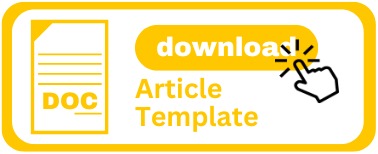PROFIL PENGGUNAAN ANTIKOAGULAN PADA PASIEN COVID-19 DI IRNA FATMAWATI RSUD DR M YUNUS BENGKULU
DOI:
https://doi.org/10.33088/jmk.v15i1.741Keywords:
Anticoagulants, Covid-19, Bengkulu HospitalAbstract
Problems: COVID-19 is a respiratory infection disease caused by SARS-CoV-2. This disease can be transmitted to humans and has spread globally. One of the complication that accompanies COVID-19 is the occurrence of coagulopathy, therefore anticoagulants are used in the treatment of COVID-19. However, studies or reports on the use of anticoagulants in COVID-19 patients have never been carried out by the Research and Development Agency of the Ministry Health Republic Indonesia. The aim of the research: To determine the profile of the use of anticoagulants in COVID-19 patients being treated at IRNA Fatmawati RSUD Dr. M Yunus Bengkulu. Research method: This study is a descriptive observational study with retrospective data collection using a time limited sampling technique, where the data is taken from the medical records of COVID-19 patients being treated at IRNA Fatmawati RSUD Dr M Yunus Bengkulu and met the inclusion criteria in the April 2020?December 2021 period. The results: In this study, 258 medical records of COVID-19 patients met the inclusion criteria, with a greater proportion of male (58.1%) than female (41.9%). The greatest use of anticoagulants was at the age of 56-65 years reaching 37.6%. Fondaparinux was the most widely used anticoagulant (51.2%) followed by heparin (36.8%) and enoxaparin (12.1%). Conclusions: Men aged 56-65 years are more at risk of infection with COVID-19 and coagulopathy complications that require the use of anticoagulants.
Keywords: Anticoagulants, Covid-19, Bengkulu Hospital
Downloads
References
Barnes, G. D. et al. (2020) ‘Thromboembolism and anticoagulant therapy during the COVID-19 pandemic: interim clinical guidance from the anticoagulation forum’, Journal of Thrombosis and Thrombolysis. Springer US, 50(1), pp. 72–81. doi: 10.1007/s11239-020-02138-z.
Becker, R. C. (2020) ‘COVID-19 update: Covid-19-associated coagulopathy’, Journal of Thrombosis and Thrombolysis. Springer US, 50(1), pp. 54–67. doi: 10.1007/s11239-020-02134-3.
Boseke, M. B., Engkeng, S. and Tucunan, A. A. . (2019) ‘Determinan Perilaku Merokok Kepala Keluarga Di Kelurahan Woloan 1 Utara Kecamatan Tomohon Barat Kota Tomohon’, Kesmas, 8(7), pp. 319–327. Available at: https://ejournal.unsrat.ac.id/index.php/kesmas/article/view/26610.
Cannegieter, S. C. and Klok, F. A. (2020) ‘COVID?19 associated coagulopathy and thromboembolic disease: Commentary on an interim expert guidance’, Research and Practice in Thrombosis and Haemostasis, 4(4), pp. 439–445. doi: 10.1002/rth2.12350.
Cen, Y. et al. (2020) ‘Risk factors for disease progression in patients with mild to moderate coronavirus disease 2019—a multi-centre observational study’, Clinical Microbiology and Infection. Elsevier Ltd, 26(9), pp. 1242–1247. doi: 10.1016/j.cmi.2020.05.041.
Chandra, A. et al. (2021) ‘Anticoagulation in COVID-19: Current concepts and controversies’, Postgraduate Medical Journal, pp. 1–8. doi: 10.1136/postgradmedj-2021-139923.
Cheng, Y. J. et al. (2013) ‘Current and Former Smoking and Risk for Venous Thromboembolism: A Systematic Review and Meta-Analysis’, PLoS Medicine, 10(9). doi: 10.1371/journal.pmed.1001515.
Elviani, R., Anwar, C. and Januar Sitorus, R. (2021) ‘Gambaran Usia Pada Kejadian Covid-19’, JAMBI MEDICAL JOURNAL ‘Jurnal Kedokteran dan Kesehatan’, 9(1), pp. 204–209. doi: 10.22437/jmj.v9i1.11263.
Godino, C. et al. (2021) ‘Antithrombotic therapy in patients with COVID-19? -Rationale and Evidence-’, International Journal of Cardiology, 324(January), pp. 261–266. doi: 10.1016/j.ijcard.2020.09.064.
Klok, F. A. et al. (2020) ‘Incidence of thrombotic complications in critically ill ICU patients with COVID-19’, Thrombosis Research, 191(January), pp. 145–147. doi: 10.1016/j.thromres.2020.04.013.
Levani, Y., Prastya, A. D. and Mawaddatunnadila, S. (2021) ‘Coronavirus Disease 2019 (COVID-19): Patogenesis, Manifestasi Klinis dan Pilihan Terapi’, Jurnal Kedokteran dan Kesehatan, 17(1), pp. 44–57. Available at: https://jurnal.umj.ac.id/index.php/JKK/article/view/6340.
Miesbach, W. and Makris, M. (2020) ‘COVID-19: Coagulopathy, Risk of Thrombosis, and the Rationale for Anticoagulation’, Clinical and Applied Thrombosis/Hemostasis, 26, p. 107602962093814. doi: 10.1177/1076029620938149.
Pivonello, R. et al. (2021) ‘Sex Disparities in COVID-19 Severity and Outcome: Are Men Weaker or Women Stronger?’, Neuroendocrinology, 111(11), pp. 1066–1085. doi: 10.1159/000513346.
Poterucha, T. J., Libby, P. and Goldhaber, S. Z. (2017) ‘More than an anticoagulant: Do heparins have direct anti-inflammatory effects?’, Thrombosis and Haemostasis, 117(03), pp. 437–444. doi: 10.1160/TH16-08-0620.
Ruhyat, E. (2021) ‘Perilaku Merokok di Masa Covid-19’, Jurnal Sehat Masada, 15(1), pp. 180–187. doi: 10.38037/jsm.v15i1.178.
Russo, V. et al. (2020) ‘Thromboprofilaxys With Fondaparinux vs. Enoxaparin in Hospitalized COVID-19 Patients: A Multicenter Italian Observational Study’, Frontiers in Medicine, 7(November), pp. 4–8. doi: 10.3389/fmed.2020.569567.
Satuan Tugas Penanganan COVID-19 (2022) Percepatan Penanganan COVID-19 di Indonesia (Update per 25 Januari 2022). Available at: https://covid19.go.id/artikel/2022/01/25/percepatan-penanganan-covid-19-di-indonesia-update-25-januari-2022.
Seftiya, A. and Kosala, K. (2021) ‘Epidemiologi Karakteristik Pasien Covid-19 di Kalimantan Utara’, Jurnal Sains dan Kesehatan, 3(5), pp. 645–653. doi: 10.25026/jsk.v3i5.542.
Tang, N. et al. (2020) ‘Anticoagulant treatment is associated with decreased mortality in severe coronavirus disease 2019 patients with coagulopathy’, Journal of Thrombosis and Haemostasis, 18(5), pp. 1094–1099. doi: 10.1111/jth.14817.
Thachil, J. et al. (2020) ‘ISTH interim guidance on recognition and management of coagulopathy in COVID?19’, Journal of Thrombosis and Haemostasis, 18(5), pp. 1023–1026. doi: 10.1111/jth.14810.
WHO (2020) The coronavirus disease (COVID-19) and the virus that causes it. Geneva. Available at: https://www.who.int/emergencies/diseases/novel-coronavirus-2019/ technical-guidance/naming-the-coronavirus-disease-(covid-2019)-and-the-virus-that-causes-it.
Willim, H. A. et al. (2020) ‘Koagulopati pada Coronavirus Disease -2019 ( COVID-19 ): Tinjauan pustaka’, Intisari Sains Medis, 11(3), pp. 749–756. doi: 10.15562/ism.v11i3.766.
Wulandari, A. et al. (2020) ‘Hubungan Karakteristik Individu dengan Pengetahuan tentang Pencegahan Coronavirus Disease 2019 pada Masyarakat di Kalimantan Selatan’, Jurnal Kesehatan Masyarakat Indonesia, 15(1), p. 42. doi: 10.26714/jkmi.15.1.2020.42-46.













